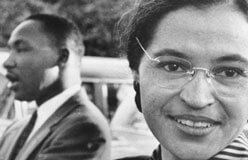Rosa Parks had endured prejudice, bigotry, and injustice all her life. She knew this was unfair and unjust.
What made it worse was that there were laws that supported the unjust treatment of black people. The police and government did not treat everyone equally. They did not protect everyone equally. When Rosa Parks refused to give up her seat on the bus in Montgomery, Alabama, she inspired millions of people to speak out for civil rights. She is known as the Mother of the Civil Rights Movement.


